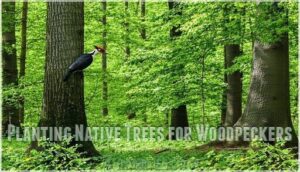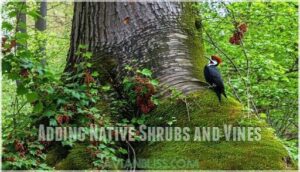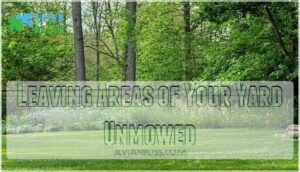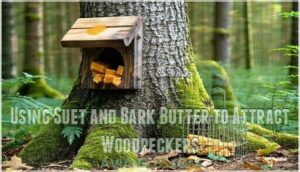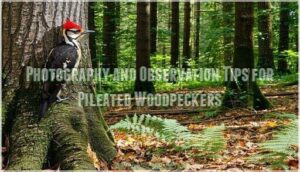This site is supported by our readers. We may earn a commission, at no cost to you, if you purchase through links.

Start by planting native trees like American Basswood and Wild Cherry. Leave dead trees standing or pile up fallen logs—these are insect buffets for woodpeckers. Put out high-energy suet that mimics the fat-rich larvae they naturally feed on.
Set up a birdbath with moving water near trees so they can escape quickly if needed. And here’s the key: don’t clean up everything. These birds need wild, untidy spaces where natural food sources thrive.
Get the habitat, food, and water right, and you’ll turn your backyard into the kind of place pileated woodpeckers actually want to visit—not just pass through.
Table Of Contents
- Key Takeaways
- Creating a Pileated Woodpecker Habitat
- Feeding Pileated Woodpeckers in Your Backyard
- Attracting Pileated Woodpeckers With Water Features
- Understanding Pileated Woodpecker Behavior and Habitat
- Photography and Observation Tips for Pileated Woodpeckers
- Frequently Asked Questions (FAQs)
- How do I attract pileated woodpeckers to my backyard?
- What is a pileated woodpeckers’ favorite food?
- Will pileated woodpeckers come to a feeder?
- How rare is it to see a pileated woodpecker?
- What are Pileated Woodpeckers favorite foods to forage?
- How can I differentiate between male and female Pileated Woodpeckers?
- What is the typical lifespan of a Pileated Woodpecker?
- How do Pileated Woodpeckers communicate with each other?
- How long do pileated woodpeckers typically live?
- Are pileated woodpeckers aggressive toward other birds?
- Conclusion
Key Takeaways
- Create a woodland sanctuary by planting native trees like American Basswood and Wild Cherry, leaving dead snags standing for nesting and foraging, and resisting the urge to manicure—these crow-sized birds thrive where wild edges meet intentional habitat design.
- Offer high-energy foods that mimic their natural diet, including suet cakes, bark butter smeared in tree crevices, peanuts, and fresh berries like blackberries and elderberries, positioned on sturdy feeders mounted vertically near mature trees.
- Install water features with movement such as birdbaths 2-3 inches deep with misters or drippers positioned near trees for quick escapes—the sound and sight of moving water attracts these birds from surprising distances.
- Leave unmowed areas and wood piles to foster insect populations like carpenter ants and beetle larvae, the protein-packed foundation of their diet, while supporting the ecosystem balance that transforms your backyard into genuine pileated woodpecker territory.
Creating a Pileated Woodpecker Habitat
Want pileated woodpeckers in your yard? Start with habitat. Native trees, a few dead snags, wild shrubs, and some untamed corners create the kind of woodland edge these birds look for.
Planting Native Trees for Woodpeckers
If you want to roll out the red carpet for North America’s most impressive woodpecker, you’ll need to think like a forest architect—and that starts with planting the right native trees.
American Basswood and Wild Cherry are prime choices for woodpecker habitat creation, attracting the insects these birds crave while supporting forest regeneration and biodiversity conservation.
Choose tree species that match your local climate—your woodland habitat becomes their natural hunting ground, turning wildlife-friendly gardening into a living invitation for Pileated Woodpeckers.
Incorporating Dead Trees and Wood Piles
Dead wood isn’t just debris cluttering your yard—it’s the lifeblood of a thriving Pileated Woodpecker habitat. Standing snags and strategically placed wood piles create perfect foraging grounds where carpenter ants and beetle larvae flourish in the timber decay process.
If local dead tree management regulations allow, preserve those weathered trunks—they’re prime real estate for nesting cavities. Your woodpile mimics natural forest floor ecology, turning ordinary woodland habitat into a woodpecker paradise while supporting wildlife conservation right in your backyard.
Adding Native Shrubs and Vines
Think of native shrubs and vines as the bridge between your woodpecker’s main course—those carpenter ants in dead wood—and a buffet of berries, fruits, and insect-attracting blooms that’ll keep these crimson-crested beauties coming back year-round. Smart native plant selection transforms your wildlife gardening project into thriving woodpecker habitat creation:
- Elderberry and sumac produce berries pileated woodpeckers actually eat while attracting insect prey
- Wild grape vines offer nesting cover and seasonal fruits, supporting ecosystem balance
- Blackberry thickets create safe foraging zones where these crow-sized birds feel protected
- Dogwood and holly maintain year-round interest, anchoring your woodpecker conservation efforts alongside native trees
Leaving Areas of Your Yard Unmowed
Your lawn might look neat and tidy when it’s clipped to flawlessness, but to a Pileated Woodpecker, that manicured grass is basically a biological desert. Unmowed areas sustain native grasses and wildflowers that attract carpenter ants, beetles, and other insects—the protein-packed foundation of woodland ecosystems. This wildlife-friendly gardening approach strengthens ecosystem balance and biodiversity sustenance while creating authentic woodpecker habitat.
| Unmowed Area Benefits | Wildlife Impact | Maintenance Level |
|---|---|---|
| Native grass patches | High insect populations for foraging | Mow 2-3 times yearly |
| Meadow borders (10+ feet) | Nesting material + prey abundance | Seasonal trim only |
| Woodland edge zones | Prime Pileated Woodpecker territory | Minimal intervention |
Backyard habitat creation doesn’t mean total abandonment—strategic unmowed zones near wooded edges work best for wildlife conservation.
Feeding Pileated Woodpeckers in Your Backyard
If you want to feed these stunning birds, focus on what they actually eat in the wild—carpenter ants and beetles are their main course, with wild fruits filling in when bugs are hard to find.
You can replicate this menu in your backyard by offering suet, bark butter, peanuts, and fresh berries, transforming your space into a pileated woodpecker paradise.
Types of Food Pileated Woodpeckers Love to Eat
If you’re serious about drawing these forest giants into your world, you’ll need to think like they do: food first, everything else second. Pileated Woodpeckers live for insects—carpenter ants top the list at up to 97% of some birds’ diets, with beetle larvae and termites rounding out the protein menu.
But don’t overlook their wild side: they’ll devour blackberries, elderberries, and sumac when foraging habits shift seasonally. Toss in peanuts for quick energy, and you’ve cracked the code on woodpecker diet and nutrition that actually works. Understanding their food source preferences is essential for attracting them to your backyard.
Using Suet and Bark Butter to Attract Woodpeckers
If you want to roll out the red carpet for Pileated Woodpeckers, suet and bark butter are your secret weapons—these calorie-dense foods mimic the fat-rich larvae these birds hammer through dead wood to find. You’ll want to offer them in woodpecker feeders that replicate natural foraging conditions. Think log feeders with drilled holes or suet cages mounted vertically against tree trunks.
Here’s how to make the most of these high energy foods:
- Mix your own suet recipes using rendered beef fat, peanut butter, and crushed nuts for optimal appeal
- Smear bark butter directly into tree bark crevices where woodpeckers naturally hunt
- Choose suet cakes without fillers—pure fat and protein work best
- Mount suet feeders near mature forest edges where these birds feel secure
- Revitalize your offerings regularly; rancid suet won’t attract anything but flies
These attracting techniques work because you’re speaking the woodpecker’s language—offering exactly what their bodies crave.
Offering Fresh Fruits and Nuts to Woodpeckers
While suet gets all the glory, fresh fruits and nuts can be just as irresistible to these forest giants—especially when insect populations dip or seasonal cravings kick in. You’ll want to offer blackberries, elderberries, and hackberry alongside peanuts and acorns.
Here’s what works:
Fresh Fruit Options Nut Selection
Place these near suet feeders, restock seasonally, and watch woodpecker preferences emerge through your bird feeding observations.
Choosing The Right Bird Feeder for Woodpeckers
A pileated woodpecker won’t cling to just any feeder—these crow-sized birds need sturdy platforms that can handle their weight and their wild, hammering style.
Go for tail-prop suet feeders or large hopper designs with solid perching ledges. Mount them on tree trunks rather than poles, and keep bird feeder placement close to wooded cover where these impressive birds feel safe foraging.
Attracting Pileated Woodpeckers With Water Features
Pileated woodpeckers need fresh water year-round—both for drinking and keeping their feathers clean.
Add a birdbath, fountain, or misting system that creates movement and sound, and you’ll grab their attention while meeting this basic need.
Set up a birdbath, fountain, or misting system that splashes and gurgles, and you’ll not only draw in these eye-catching woodpeckers but also give them the fresh water they need.
Installing a Bird Bath for Woodpeckers
Water isn’t just for drinking—it’s where these stunning birds come alive, splashing and preening with the enthusiasm of kids at a summer pool party. Setting up the right bird bath can turn your backyard into a woodpecker oasis. Here’s what you need to know about Bird Bath Placement and attracting woodpeckers:
- Choose depth wisely: Your bird bath should be 2-3 inches deep for proper Woodpecker Hydration and Bathing Habits
- Location matters: Position it near trees or large shrubs to give these woodpecker species natural perches and quick escape routes
- Material selection: Opt for Bird Friendly Materials like stone, metal, or recycled plastic that withstand vigorous use
- Shade is your friend: Place in shaded areas to keep water cool and reduce evaporation
- Keep it fresh: Regular cleaning prevents bacteria buildup and keeps Pileated Woodpeckers coming back
Smart Water Feature Design transforms your wildlife friendly gardening efforts into a thriving habitat.
Creating a Woodpecker-Friendly Water Feature
Think of it this way: you wouldn’t ask a crow to drink from a teacup, so why expect a bird the size of one to squeeze into a shallow dish meant for sparrows? Your water feature design needs heft—a basin at least 12 inches across and 2-3 inches deep creates a proper fresh water source.
Position it near perching limbs but not too close to dense cover where predators lurk. Keep up with bird bath maintenance by scrubbing weekly, and you’ll build a woodpecker-friendly habitat that fosters real wildlife habitat creation.
Adding a Misting System to Your Bird Bath
Misting systems transform an ordinary bird bath into something like a natural woodland spring. Those tiny water droplets catch the light and create movement that Pileated Woodpeckers simply can’t resist. You’ll want spray nozzle options that produce fine fogging effects without overwhelming your water source.
The misting system benefits extend beyond bird attraction—it keeps your backyard water feature cool during hot months and maintains a woodpecker-friendly habitat.
Remember, bird bath maintenance matters: change water regularly and clean surfaces to prevent bacterial buildup.
Using a Birdbath With Fresh Water and Movement
If you’re serious about turning your backyard into woodpecker paradise, the secret isn’t just having a birdbath—it’s making that water irresistible. Pileated woodpeckers can’t resist fresh water paired with movement systems like misters or drippers.
Position your bird bath near trees for quick escape routes, keep the water shallow (1-2 inches), and maintain it religiously. Movement catches their attention from surprising distances, transforming a simple water source into a woodpecker magnet that’ll bring these crow-sized beauties straight to your backyard.
Understanding Pileated Woodpecker Behavior and Habitat
These crow-sized birds follow predictable patterns in feeding, nesting, and territory defense—knowledge you can use to create an irresistible habitat that keeps them coming back year after year.
Once you understand how pileated woodpeckers behave, you can actually design your yard to suit their needs.
Identifying Pileated Woodpeckers by Sight and Sound
Once you’ve set the stage with water, spotting these remarkable birds becomes your next adventure in bird watching. Pileated Woodpeckers command attention with their striking red crests—flaming triangular crowns that catch light like torches in the forest. Males sport an extra red malar stripe on the cheek; females wear black there instead.
Their bird plumage features bold white stripes slashing across black bodies, especially visible when they take flight. Listen for their wild, whinnying pileated calls and distinctive drumming patterns—roughly three seconds of 10–30 knocks that echo through mature woodlands, peaking in early spring when temperatures hover near freezing.
Understanding their need for mature woodlands is vital for effective conservation efforts.
Recognizing Pileated Woodpecker Mating and Nesting Habits
When do Pileated Woodpeckers pair up? These exceptional birds form lifelong bonds, strengthening their connection through coordinated drumming and vocal displays during early spring courtship. You’ll witness their mating rituals unfold between February and June, depending on your region.
Watch for these nesting behaviors:
- Pairs excavate cavities together in dead trees 15-70 feet high, with males doing most of the heavy lifting
- Both parents share incubation duties for 15-18 days, though males cover the night shift
- Nestlings stay in the cavity for 24-28 days before fledging, with both parents bringing food and teaching foraging skills
Understanding these Pileated Woodpecker courtship and breeding cycles helps you time nesting box installations and assist woodpecker conservation efforts in your backyard.
Learning About Pileated Woodpecker Migration Patterns
Why do Pileated Woodpeckers stick around year-round? Unlike many birds, they’re permanent residents with no true migration routes. These masters of territorial behavior make seasonal movements—montane populations shift to lower elevations in autumn, and some expand into urban woodlots as habitat changes.
This range shift reflects wildlife conservation in action: populations are climbing across their historical range. Understanding this woodpecker behavior and habitat expansion helps you foster nature conservation right in your backyard.
| Movement Type | Distance/Scale | Conservation Impact |
|---|---|---|
| Long-distance migration | None—they stay put! | Stable year-round populations |
| Seasonal elevation shifts | Local (montane to lowland) | Adaptive survival strategy |
| Habitat expansion | Growing into new territories | Population increase across range |
Creating a Pileated Woodpecker-Friendly Backyard
Your backyard can turn into a real woodpecker habitat if you’re ready to let things get a little messy. Forget the perfectly trimmed lawn. Let some corners go wild.
Attracting woodpeckers means changing how you think about yard work. Here’s what actually works:
- Leave dead trees standing as natural woodpecker houses and foraging sites
- Plant native species like basswood and wild cherry for tree selection that aids local ecosystems
- Skip the pesticides to maintain healthy insect populations for feeding
- Create brush piles from fallen branches to foster wildlife conservation and backyard birding opportunities
Photography and Observation Tips for Pileated Woodpeckers
After you’ve attracted these beautiful birds to your yard, the next step is capturing their beauty through observation and photography.
Setting up the right station and using proper techniques will help you document their behavior while respecting their space and natural rhythms.
Setting up the right station and using proper techniques will help you document their behavior while respecting their space and natural rhythms.
Setting Up a Photography Station for Woodpeckers
Capturing a crow-sized bird with a flaming red crest demands more than just pointing your lens and hoping for the best. You’ll need a well-planned photography station that gives these stunning Pileated Woodpeckers room to work while bringing them close enough for stunning shots:
- Scout feeder stations near mature trees: Position your photo blind within 15-20 feet of active woodpecker lures like suet feeders, where natural light flatters that crimson crest without harsh shadows.
- Anchor your setup with a solid tripod: Wildlife cameras and long lenses magnify every tremor, so stability separates sharp backyard birding shots from blurry disappointments.
- Create unobstructed sight lines: Clear small branches between your camera placement and feeding zones, letting you track these cautious birds without spooking them during their foraging runs.
Choosing The Right Camera and Lens for Woodpecker Photography
When you’re stalking these crow-sized dynamos through the forest canopy, the gap between a blurry blob and a frame-worthy shot comes down to your glass—and I’m not talking about your morning coffee mug.
You’ll want a lens with a focal length between 300-600mm for nature photography that doesn’t spook your subject. Pair that with fast aperture control (f/5.6 or wider) and image stabilization, and you’ve got the setup to freeze those dramatic drumming sessions mid-strike.
Using a Bird Window to Observe and Photograph Woodpeckers
A bird window transforms your viewing experience from distant observer to privileged witness, bringing these splendid drummers within arm’s reach of your lens. UV-reflecting glass prevents collisions while maintaining clarity for nature photography.
Position it near suet feeders where woodpecker behavior patterns naturally unfold. This observation technique lets you capture intimate moments—foraging strikes, crest displays, territorial drumming—without disturbing your subjects.
Perfect your camera settings beforehand, then watch these crow-sized beauties work their magic inches away.
Tips for Getting Up-Close Shots of Pileated Woodpeckers
Getting close enough to photograph these stunning crow-sized birds takes more than luck—it demands a blend of stealth, timing, and respect for their wild nature. Here’s how to master shooting techniques for bird photography and observation:
- Choose wildlife lenses with 400mm+ reach to maintain respectful distance while capturing detail
- Study bird behavior patterns—they’re most relaxed during foraging sessions
- Experiment with camera angles by positioning yourself at trunk level where they work
- Perfect your photo editing to bring out those striking red crests and white facial stripes
Patience always wins when attracting woodpeckers to your lens.
Frequently Asked Questions (FAQs)
How do I attract pileated woodpeckers to my backyard?
Dead trees aren’t eyesores—they’re pileated woodpecker magnets. Add suet feeders and plants that attract carpenter ants, and you’ve built the kind of habitat these crow-sized birds actually need.
To break free from generic backyard birding tips and truly welcome these crow-sized giants, you’ll need dead trees (snags), suet-packed bird feeders, and woodpecker-friendly plants.
Creating a backyard that mirrors their wild forest home with abundant carpenter ants and safe nesting spots is key.
What is a pileated woodpeckers’ favorite food?
If you’re curious about dietary needs, carpenter ants are the clear winner—they make up about 40% of what these birds eat.
Pileated Woodpeckers also devour beetle larvae, termites, and other insects while foraging, plus they’ll happily snack on suet, peanut butter, and wild fruits like blackberries when you offer them.
Will pileated woodpeckers come to a feeder?
Good news: pileated woodpeckers absolutely visit bird feeders, especially when suet preferences align with their natural woodpecker diet.
Feeder placement matters—they favor sturdy platforms near trees.
Offering bark butter boosts bird attraction success, turning casual visitors into reliable regulars at your feeding station.
How rare is it to see a pileated woodpecker?
Seeing Pileated Woodpeckers isn’t as rare as you’d think—around 6 million inhabit North America, and their populations are climbing. Yet spotting one takes patience, since these elusive birds protect their woodland nesting territories fiercely.
What affects your Pileated Woodpecker sightings:
- Habitat quality matters—mature forests with abundant dead trees boost your chances, while sparse woodland density reduces bird population density.
- Attracting woodpeckers through bird-friendly gardening—offering suet and leaving snags fosters opportunities for wildlife conservation and better viewing.
- Understanding their behavior—listen for their distinctive drumming and calls, essential bird watching tips that reveal their presence before you spot them.
What are Pileated Woodpeckers favorite foods to forage?
In the wild, Pileated Woodpeckers hunt carpenter ants relentlessly, devour wood-boring beetle larvae with precision, and strip termites from rotting wood.
They supplement this insect prey with wild fruits like blackberries and elderberries, plus nuts when available.
How can I differentiate between male and female Pileated Woodpeckers?
You’ll spot the difference in their head markings—males sport a bold red stripe across the cheek, while females show a sleek black stripe instead.
Here’s what to watch for during birdwatching:
- Male Pileated Woodpeckers flash that signature red "mustache" stripe from beak to neck
- Females wear black cheek stripes with subtle grey patches between beak and eyes
- Both sexes share that flaming red crest, though crest shape varies slightly
- Feather patterns remain nearly identical across woodpecker plumage otherwise
This sexing technique makes ornithology accessible to anyone building a woodpecker-friendly habitat or practicing wildlife conservation and gardening.
What is the typical lifespan of a Pileated Woodpecker?
In the wild, these splendid birds usually live 10–15 years, though some individuals have reached 20 years under ideal conditions.
Woodpecker longevity depends heavily on habitat quality, predation pressure, and food availability—factors directly linked to woodland creation and wildlife conservation efforts that aid healthy pileated populations.
How do Pileated Woodpeckers communicate with each other?
Pileated Woodpeckers break the silence of forests with their own bold language. They communicate through drumming sounds—powerful, rapid-fire beats that echo through the trees—and distinctive vocal calls like their wild "wuk-wuk-wuk" series. Here’s how they speak:
- Drumming Sounds announce territory and attract mates with thunderous percussion
- Vocal Calls include cackles and series notes for alarm and contact
- Visual Displays feature crest-raising and wing-spreading during courtship behaviors
- Territorial Markings through excavated cavities signal occupation to rivals
How long do pileated woodpeckers typically live?
In the wild, these splendid birds clock up to 12 years, though field studies suggest some reach 15.
Lifespan factors like forest ecology, wildlife habitat quality, and mortality rates from predators shape survival trends.
Average life spans reflect ecosystem health—woodpecker longevity tells us about environmental sustainability.
Are pileated woodpeckers aggressive toward other birds?
These impressive birds aren’t particularly aggressive, but they’ll defend their territory during nesting season and at bird feeders. You’ll usually see woodpecker territoriality manifest as displays rather than physical confrontations.
Common scenarios for bird aggression include:
- Feeding fights at suet feeders, where they’ll chase smaller woodpeckers like downies and hairies away from prime spots
- Nesting conflicts during breeding season (mid-May through mid-July), when pairs vigorously protect cavity sites in their backyard birding territory
- Territorial drumming on resonant surfaces to announce boundaries and discourage avian interactions with intruders
- Displacement behavior at woodpecker-friendly habitat features, though they usually tolerate non-competing species in bird-friendly gardening spaces
- Mate guarding by males showing their red cheek stripe, occasionally resulting in brief confrontations with rivals
Conclusion
Think of your yard as a stage where ancient forest rhythms play out. When you learn how to attract pileated woodpeckers, you’re not just feeding birds, you’re rewiring your landscape back to its wild blueprint.
Attracting pileated woodpeckers means rewiring your landscape back to its wild blueprint—let dead wood stand, offer rich suet, and create authentic forest habitat
Let dead wood stand like monuments, offer suet that rivals carpenter ants in richness, and watch water ripple near escape routes. These crow-sized architects don’t adapt to manicured lawns; they demand authenticity, and your reward is their drumming echoing through morning fog.
- https://www.pacificorp.com/content/dam/pcorp/documents/en/pacificorp/energy/hydro/lewis-river/license-implementation/hep-models/USFWS_HSI_PileatedWoodpecker.pdf
- https://meridian.allenpress.com/jfwm/article/5/2/198/210466/Occupancy-Modeling-of-Woodpeckers-Maximizing
- https://www.fs.usda.gov/pnw/sciencef/scifi109.pdf
- https://nrm.dfg.ca.gov/FileHandler.ashx?DocumentID=7121
- https://barrie.wbu.com/attracting-pileated-woodpeckers

